transcript
transcript
Washington Grapples With Coronavirus Surge
Mayor Muriel E. Bowser of Washington urged residents to be vigilant against the coronavirus on Monday, and announced that any resident 65 or older could make an appointment to receive the vaccine.
-
Even in these tumultuous days, our experience with Covid, we remain concerned, as the rest of the country remains concerned, about increase in cases. I am requesting that the Secretary of the Department of the Interior cancel any and all public gathering permits in the District of Columbia and deny any applications for public gathering during the period Jan. 11 through Jan. 24. In addition to heeding our call only to participate in inauguration events virtually, I am also asking D.C. residents to sign up for special Inauguration Day alerts. Our Department of Health has worked through our phasing criteria for the vaccine, and today we move into yet another phase of vaccine eligibility. Beginning today, D.C. residents 65 years old and older can make an appointment to get the Covid vaccine through the vaccinate.dc.gov portal.
While Mayor Muriel E. Bowser of Washington, D.C., was grappling with the riot that tore through the Capitol last week, another crisis was slowly unfolding: a surge of coronavirus in the district.
Washington averaged 290 new coronavirus cases a day in the seven-day period that ended Sunday, the most the city has seen during any week of the pandemic. The surge is part of a broader upward tide throughout the nation’s Mid-Atlantic region: Virginia, Maryland and Delaware also set weekly case records on Sunday.
On Monday, Ms. Bowser urged vigilance against the virus, noting that the district’s hospitals were strained by coronavirus patients and the rate of positive test results was high.
“We remain concerned — as the rest of the country remains concerned — about the increase in cases,” she said.
Public health experts warned that the district could be headed for an alarming wave of infections in the next few weeks, after the riot in the Capitol, when lawmakers and staff members huddled in small rooms to hide from attackers.
“The district is operating under a double whammy,” said Sara Rosenbaum, a professor at the Milken Institute School of Public Health at George Washington University.
The district has the challenges of any large urban center, she noted, including concentrated poverty and large numbers of vulnerable residents, making fighting the virus very difficult.
“On top of that, the district has this unique risk factor, which is exposure to thousands of people who poured into town, maskless, packed into very concentrated areas, and simply ignoring every public health safety precaution,” Ms. Rosenbaum said.
“We won’t know for the next couple of days whether we have a further skyrocketing of cases, but it had all the attributes of what we have all come to understand is a superspreader event — which is huge numbers of people packed together indoors, screaming.”
Washington’s latest surge predates last week’s riot, and not enough time has elapsed for the scale of infections that occurred that day to show up in the district’s data. The full impact may never be known: Infections are generally counted where a person lives, so out-of-town residents who caught the virus during the unrest would not be included in Washington’s case count.
After enduring a spring surge, Washington kept its case numbers relatively low through the summer and into the fall. On Oct. 1, the district, with about 700,000 residents, was averaging fewer than 40 new cases a day.
The outlook has worsened since then. Case numbers rose steeply for two months and peaked in early December. They ebbed a bit in the days before Christmas, but that progress was undone in the first days of 2021.
Around the city, the streets continue to bustle with traffic, but everything else is eerily quiet. Museums and theaters are closed, restaurants are limited to outdoor diners and takeout, and downtown sidewalks are all but empty. More than half the city’s residents have taken a Covid-19 test. Depending on the time of day, the lines of people waiting for free tests at firehouses and community centers can stretch for blocks, and hours.
One bright spot: The city’s vaccination program is gaining steam. On Monday, it began scheduling shots for anyone 65 or older.
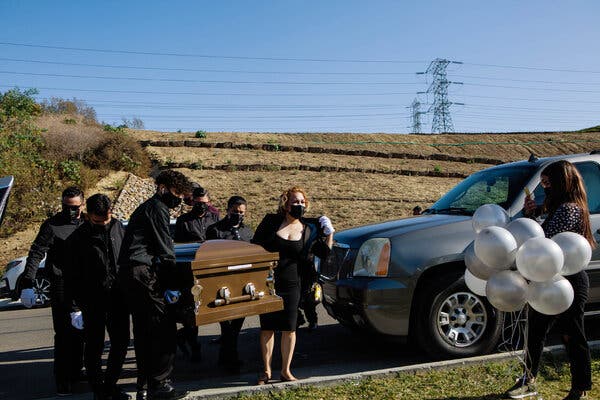
Whatever else the dawn of 2021 has brought, it has not slowed the relentless mounting of the pandemic’s toll in the United States. The nation’s seven-day average of coronavirus-related deaths has broken past 3,000 a day, reaching 3,249 on Sunday. And the cumulative total of virus deaths surpassed 375,000 on Monday, according to a New York Times database.
California alone reported more than 3,300 virus deaths in the week ended Sunday. No state except New York has recorded more than that in a single week.
The dire statistics follow a surge in new cases and hospitalizations that has extended to every part of the country. On average, 254,866 new cases a day have been reported over the past week, 38 percent more than two weeks earlier. As of Monday morning, a total of more than 22.4 million people in the United States have tested positive.
Health care facilities that have been scrambling to treat patients are also struggling to vaccinate people, amid widespread frustration and confusion across the country. With states and counties left largely to sort out the logistics by themselves, the vaccination program has gone anything but smoothly.
As of Monday, nearly nine million people had received at least one dose of a Covid-19 vaccine, far short of the federal goal of 20 million people or more by Dec. 31.
The federal government said Friday that it had delivered more than 22.1 million vaccine doses to states, territories and federal agencies. The same day, President-elect Joseph R. Biden Jr. said he would release nearly all available doses of the vaccine to states as soon as he is inaugurated. Federal officials have been holding back millions of vials to ensure that second doses will be available to those who received the first.
States have also begun broadening access to the shots faster than planned, amid tremendous public demand. Some states, including New York, Florida, Louisiana and Texas, have already expanded who is eligible to get a vaccine now, even though many people in the first priority group recommended by the Centers for Disease Control and Prevention — the nation’s 21 million health care workers and three million residents of nursing homes and other long-term care facilities — have yet to receive a shot.
Mr. Biden received his own second injection on Monday. His team said he would invoke the Defense Production Act if necessary to ensure that second doses can be given on schedule.
“My No. 1 priority is getting vaccine into people’s arms,” Mr. Biden said after taking a quick needle jab. The President-elect said he and his advisers were finalizing a plan to accelerate mass vaccinations nationwide that he would release on Thursday.
“Three to four thousand people dying a day is just beyond the pale,” he said.
Mr. Biden lamented that mask-wearing continues to be a politically divisive issue, and said he was “appalled” to hear that, during last week’s storming of the U.S. Capitol, some Republican House members refused pleas from a Democratic colleague to don masks while they were crowded together in a secure protective location.
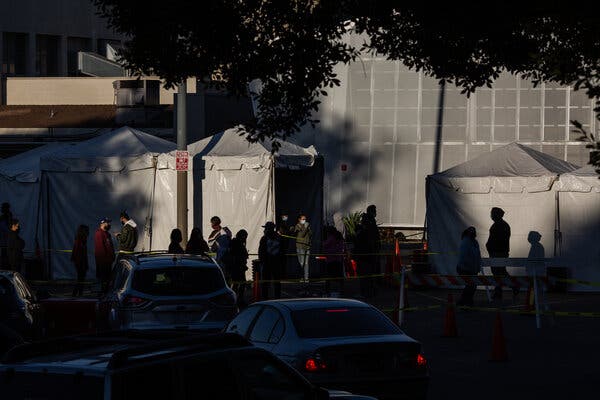
In earlier stages of the pandemic, the states with the most coronavirus cases often bordered one another. Major outbreaks were concentrated in geographic regions of the United States: the Northeast in the spring, the Sun Belt over the summer and the country’s midsection in the fall.
Now, the five worst-hit states are scattered around the country: Arizona, California, Oklahoma, Rhode Island and South Carolina are averaging the most daily new cases per person, according to a New York Times database.
One threat they have in common is the post-holiday surge of the virus that has thrust the United States into its darkest days of the pandemic, with cases rising in nearly every state. The country reported 300,594 new cases on Friday and more than 4,100 deaths on Thursday, both single-day records. In total, more than 374,000 have died from Covid-19 in the United States.
The emergence of more contagious variants has added urgency to the country’s vaccine rollout, which has gotten off to a slow start.
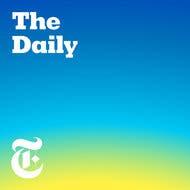
Listen to ‘The Daily’: A Pandemic Update: The Variant and the Vaccine
With the coronavirus at a peak in the United States, we look at the latest in the fight against the disease.
In November, most of the worst-affected states were in the Upper Midwest and Mountain West. Wisconsin had been a focus for its startling positivity rates — over 30 percent at one point — and its field hospitals reopening. As soon as those cases started to decline, states like Indiana, Kansas and Rhode Island had surges.
“It never really dropped,” said Dr. Michael Osterholm, the director of the Center for Infectious Disease Research and Policy at the University of Minnesota. “We transferred risk from one area to another.”
He believes people restrict their socializing habits when they experience an outbreak and then relax them when the numbers go down, leading to new surges.
Here’s a snapshot of how the five worst-off states are grappling with the virus:
-
Arizona, for the second time, is shattering its records and reporting more new cases each day per capita than any other state. Nearly 5,000 Arizonans were hospitalized with the virus as of Sunday — more than in July, the state’s previous peak. Vaccines are being administered at among the lowest rates in the country.
-
California’s devastating surge is concentrated in the southern part of the state, where emergency rooms have had to shut their doors to ambulances for hours at a time. Nearly one in 10 people have tested positive for the virus in Los Angeles County, the nation’s most populous. The surge of hospitalizations has caused problems for the oxygen delivery and supply system used by medical facilities.
-
In Oklahoma, daily caseloads have increased 40 percent in the past two weeks. Overstretched hospitals have put patients in hallways and converted conference rooms into treatment areas, The Tulsa World reported. The state’s online vaccine portal, to avoid crashing, took up to 48 hours to send emails confirming registrations, causing confusion for many.
-
Rhode Island, which aggressively handled its spring surge, has the worst outbreak of any Northeastern state. After the start of the school year in early September, case numbers began climbing steadily and have not slowed. It had a seven-day average of 130 cases per 100,000 people, the highest per capita rate in the country. One factor, experts say, is the state’s population, which is poorer, older and more densely packed than its neighbors’.
-
South Carolina has more than doubled its average cases over the past two weeks. More than 30 percent of coronavirus tests given over the past week were positive, according to state data, and five counties reported their hospitals’ acute care beds were full, The Post and Courier reported. The state ranks among the nation’s lowest in its vaccine administration rate, according to Centers for Disease Control and Prevention data compiled by The State, with many health care workers hesitant to get inoculated.

Representative Bonnie Watson Coleman of New Jersey tested positive for the coronavirus on Monday — an infection she believes is linked to the time she spent in a secure location with colleagues who refused to wear masks during Wednesday’s siege of the U.S. Capitol.
“It angers me when they refuse to adhere to the directions about keeping their masks on,” Ms. Watson Coleman, a Democrat, said in an interview. “It comes off to me as arrogance and defiance. And you can be both, but not at the expense of someone else.”
On Sunday, Representative Chuck Fleischmann, Republican of Tennessee, who was also in protective isolation, announced that he had tested positive for the virus after being exposed to his roommate, Gus Bilirakis of Florida, also a Republican.
Mr. Fleischmann told local news station WRCB that he was notified Wednesday that Mr. Bilirakis had tested positive, but did not receive the notification because he was locked down in a secure location amid the riots. He said he did not know how many other lawmakers he had come in contact with.
Mr. Fleischmann and another lawmaker who tested positive, Representative Jake LaTurner of Kansas, both were at the Capitol on Wednesday to object to the certification of the electoral vote.
Ms. Watson Coleman said she and her husband, William Coleman, took a rapid antigen test on Monday. Her husband tested negative for the virus, she said. Ms. Watson Coleman is now isolating and awaiting the results of a more accurate laboratory P.C.R. test. She began to feel symptomatic within the past 24 hours, and is experiencing “mild, cold-like symptoms,” including a cough and a raspy sore throat.
Most antigen tests are thought to perform best when used by people who recently started experiencing symptoms.
Ms. Watson Coleman, a lung cancer survivor who will turn 76 next month, has represented the 12th Congressional District, a district north of Trenton that cuts across four central New Jersey counties, since 2015. She had gotten one dose of the Pfizer-BioNTech Covid-19 vaccine on Dec. 29.
“I want people to know that this is very serious and that our exposure is because of people who don’t care about anybody else and are ignoring science and acting out of an abundance of stupidity,” she said.
Illnesses identified before someone has completed their full Covid-19 vaccination schedule should not cause concern, experts said.
The Pfizer-BioNTech vaccine has been authorized as a two-dose vaccine, with the second shot administered about three weeks after the first. While some protection appears to kick in after the first injection, it takes the body at least a week or two to develop a measurable immune response to the virus after its first exposure to the vaccine. The second shot clinches the protective process.
If Ms. Watson Coleman was indeed exposed to the virus just a week after her first injection, she was likely about as vulnerable to it as she was before the shot.
On Sunday, Congress’s Office of the Attending Physician said that House lawmakers may have been exposed to someone who was infected with the coronavirus while they were sheltering in a secure location as a mob of pro-Trump extremists stormed the Capitol last week.
In an email sent to lawmakers, Dr. Brian P. Monahan, the attending physician, said that while “the time in this room was several hours for some and briefer for others,” during that period, “individuals may have been exposed to another occupant with coronavirus infection.” He told lawmakers to obtain a P.C.R. test as a precaution and continue taking preventive steps against the spread of the virus.
transcript
transcript
Newsom Broadens Who Can Administer Vaccines
Gov. Gavin Newsom of California described an “all-hands-on-deck approach” that will allow a wider range of health care workers, including pharmacists and dentists, to administer the coronavirus vaccine.
-
We are sending an urgent call across the spectrum, our health care partners, our legislative partners, as well as labor and business partners up and down the state, this notion of an all-hands-on-deck approach to accelerate the equitable and safe distribution of vaccines. Again, we’re not losing sight of the issue of equity. We’re not losing sight of the imperative to prioritize the most vulnerable and the most essential. So that’s why we talk about our special efforts to vaccinate the vaccinators as part of an all hands on deck — the slide that represents the number of categories of individuals and groups that can currently vaccinate. And you can see the myriad of different registered nurses, physician assistants and the like. But we recognize more folks need to have that ability. And that’s why you recall a week or so ago, we talked about our efforts on pharmacists and pharm techs. We’re seeing more and more paramedics partnering with the counties. Local health officers are encouraging this and we are very supportive of EMTs as this local option for additional vaccinators to help administer these vaccines faster.
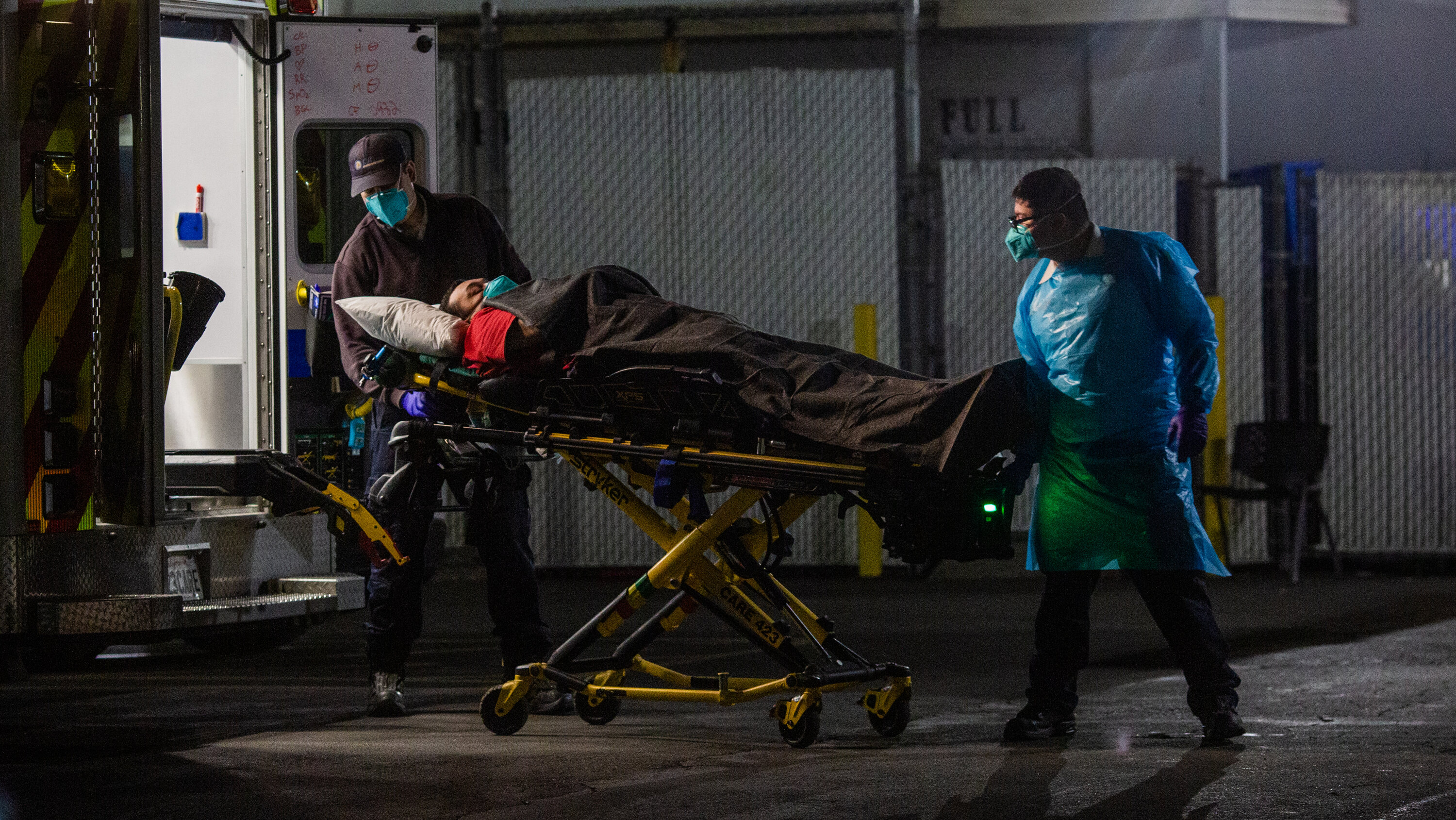
California officials on Monday described widespread efforts to speed up vaccinations as the state continues to struggle with a tsunami of new Covid-19 cases that have stretched hospitals to their limits.
The state has loosened what leaders have described for weeks as a carefully drafted, strict vaccine prioritization and is moving into what Gov. Gavin Newsom called an “all-hands-on-deck approach.”
That includes transforming Dodger Stadium from one of the nation’s biggest and most visible Covid-19 testing sites into a mass vaccination center; the San Diego Padres’ stadium and the state fairgrounds in Sacramento were also being set up as vaccination sites, the governor said.
Mr. Newsom said that as of Sunday, the state had received almost 2.5 million doses of the vaccines, and that 783,476 had been administered.
The state’s vaccine plan laid out phases and tiers to ensure that millions of health care workers and people living in nursing homes — the top priority groups — would be vaccinated first, followed by vulnerable groups, including those 75 and older, and teachers.
But as The Los Angeles Times recently reported, surprisingly large numbers of health care workers in Los Angeles and Riverside Counties were declining to be inoculated. And relatively few people in the state have gotten vaccine doses, compared with other states and territories, according to a New York Times tracker.
Dr. Mark Ghaly, California’s secretary of health and human services, said in the Monday news conference that the state is working with counties and other local public health leaders to distribute vaccines to those who both need them and want them — without allowing wealthy people to cut the line.
Mr. Newsom said the state has allowed a broader range of workers to administer vaccines, including pharmacists and dentists, and is rolling out a public awareness campaign in 18 languages.
“People have said, ‘Well, what about sending in the National Guard?’” he said. “Well, we have the National Guard out there,” administering vaccines; Mr. Newsom also said that there are urgent efforts to “vaccinate the vaccinators.”
While public health leaders in California said on Monday there were signs that the surge may be plateauing, they also cautioned that the state is far from out of the woods.
The daily average of Covid-19 deaths in California over the last seven days is 480, according to a New York Times database. Intensive care units in Southern California and the San Joaquin Valley are still full, Mr. Newsom said, and in the Bay Area, a stay-at-home order was likely to be extended, because of low intensive care unit capacity in the region. Mr. Newsom said that in the next week, 1,000 more contract health care workers were set to help California’s exhausted doctors, nurses and more.
The governor also announced the positive tests of two San Diego Zoo gorillas on Monday, saying that the state was concerned about “our beloved gorillas.” “As I often say to you, what tends to resonate in my house I also want to make public,” Mr. Newsom said, referring to his wife and four young children.
U.S. roundup
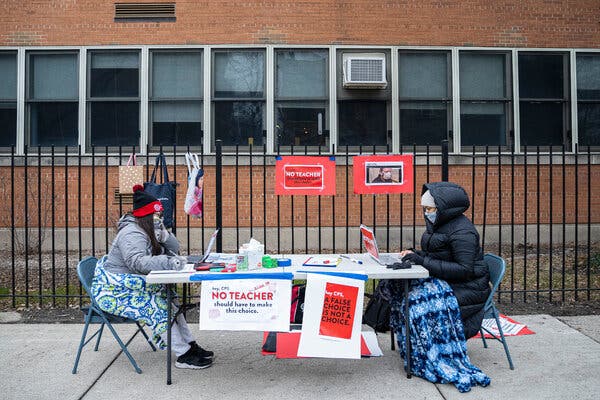
Students returned to public school buildings in Chicago on Monday for the first time since March, even as the city’s teachers union continued to attack the reopening plan as reckless and demand that it be halted.
About 6,000 prekindergarten and special education students were expected for in-person instruction, but it was unclear how many showed up.
In an early morning news conference outside the Nathan S. Davis Elementary School, union members said that 10 to 20 prekindergarten students had signed up for in-person instruction but that all of them had pulled out last week, when, perhaps not coincidentally, the union mounted a full-court press to convince parents that the reopening plan was unsafe.
Some parents “quite frankly were pretty upset to see teachers being forced into the buildings and not having all the proper equipment,” said Kate O’Rourke, a prekindergarten special education teacher.
Only prekindergarten and some special education students were eligible to return to schools this week. The rest of kindergarten through eighth grade students are eligible to return on Feb. 1. The district, the nation’s third largest, has not set a date for high school students to return.
Janice K. Jackson, the district’s chief executive, said that a majority of teachers had shown up to schools on Monday as required, but declined to be more specific. On Friday, less than 60 percent of the teachers who had been called back to prepare for the students’ return showed up. Dr. Jackson had warned the teachers on Friday that any who stayed home without permission would not be paid.
“The purpose right now and the focus for me today is not on any resistance but making sure we can educate our kids,” Dr. Jackson said, “and we started school today successfully.”
On Monday, Boston Public Schools announced that it had reached an agreement with its teachers’ union that would allow the city to begin having more students back to classrooms.
Under a tentative timeline, the district would welcome back some especially vulnerable younger students — including some students with disabilities and limited English — the week of Feb. 1, followed by the rest of kindergarten through third grade students the week of March 1.
Fourth graders through high school students would phase in over the following four weeks. Currently almost all of the district’s approximately 52,000 students learn remotely.
In other developments around the United States:
-
While sheltering in a secure location as a mob of Trump supporters stormed the Capitol on Wednesday, House lawmakers may have been exposed to someone who was infected with the coronavirus, according to the Office of the Attending Physician. In an email to lawmakers on Sunday, the attending physician to Congress, Dr. Brian P. Monahan, urged them to obtain a P.C.R. test as a precaution and to continue taking preventive steps against the spread of the virus.
-
Five new coronavirus vaccination centers opened in New York, in the latest effort to accelerate the sluggish pace that has dogged the rollout in the city. Two sites are mass vaccination centers that, starting Monday, will operate 24 hours a day, seven days a week, according to the city Department of Health.
-
Delays were reported at Ronald Reagan Washington National Airport after an air traffic control center that serves the area reported a coronavirus infection and closed for cleaning on Sunday, the Federal Aviation Administration said.
transcript
transcript
‘We Have Work to Do’: More New Yorkers Receive Vaccine
Mayor Bill de Blasio of New York announced on Monday that the city has begun administering coronavirus vaccines to residents aged 75 and older as well as a wider range of essential workers.
-
We fought hard for the freedom to vaccinate. Now we have it. Starting today, we can reach New Yorkers over 75 years old, the most vulnerable people, our seniors, our elders, we can reach them today. And we can reach so many of the people who serve us — our first responders, our essential workers. It’s a very exciting moment, a very important moment. A lot of work to do now. We’ve gotten the freedom. Now we have work to do to reach each and every person ready to get vaccinated. We have more and more sites opening up, including our 24/7 sites. And this is very exciting because there’s a lot of people ready to get the vaccine, literally all hours of the day, and we’ll be able to accommodate them in all five boroughs. For the week starting today, the goal is 175,000 New Yorkers — 175,000 doses given this week. We feel very good about that goal. We feel very good about our goal to vaccinate a million people in the course of the month of January.
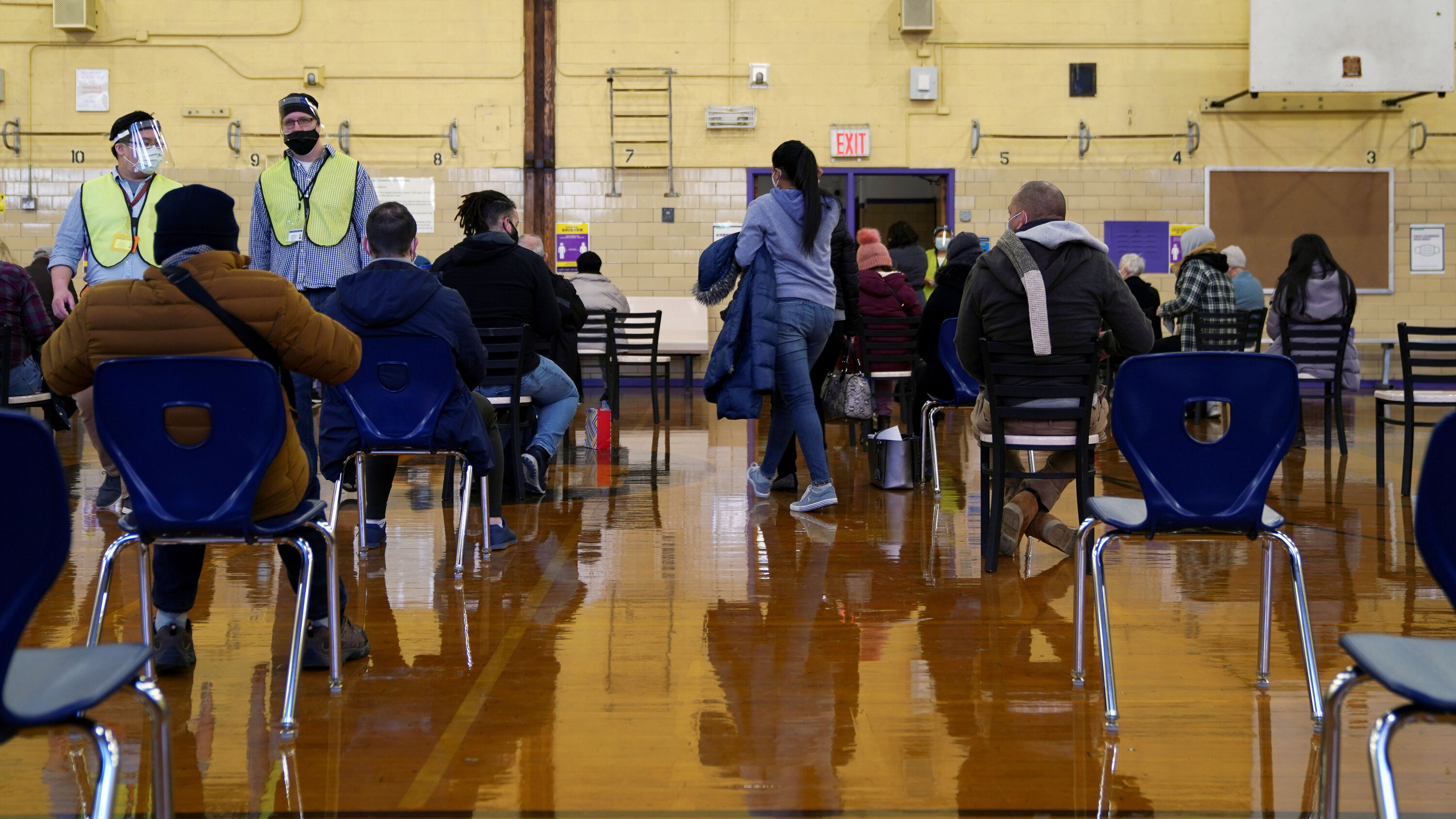
New York on Monday began giving vaccines to residents aged 75 and older as well as a wider range of essential workers, as state health officials expanded the group of people eligible to receive the vaccine.
The updated inoculation guidelines came last week after days of pressure from Mayor Bill de Blasio of New York City and an outcry over medical providers having to throw out vaccine doses because of challenges finding patients who precisely matched the state’s strict vaccination guidelines.
“We fought hard for the freedom to vaccinate,” Mr. de Blasio said at a news conference on Monday. “Now we have it.”
Among the essential workers now permitted to receive the vaccine statewide are police officers, firefighters, teachers and school administrators, public transit workers, public-facing grocery store workers and people living or working in homeless shelters who sleep or eat alongside others outside their household.
Mr. de Blasio said that 55,000 people had already scheduled appointments to be vaccinated at city-run sites. Overnight appointments between midnight and 4 a.m. were fully booked, he added.
In a television interview, the city’s police commissioner, Dermot F. Shea, said that 400 police officers received a dose of the vaccine in the first hour of the department’s vaccination efforts.
City health officials planned to push particularly hard to inoculate older New Yorkers, who are at higher risk of severe illness from the virus. To assist in this effort, the city set up a new website and phone system (1-877-VAX4-NYC) to help connect people with appointments. But Gov. Andrew M. Cuomo has warned that the eligibility expansion would move slowly and that it could take until mid-April to fully vaccinate the current groups, which total about five million New Yorkers statewide.
The city has also pushed in recent days to accelerate the pace of vaccinations. Mr. de Blasio said 101,799 doses were given last week, higher than the goal of 100,000 he had previously set.
This week, city health officials aimed to see 175,000 doses of the vaccine administered. Dave Chokshi, the city’s health commissioner, said the city had 230,000 doses on hand and expected another 100,000 delivered this week.
On Saturday, state health officials abruptly loosened guidelines, allowing medical providers to administer the vaccine to any employees who interact with the public if there are extra doses in a vial and no one from “the priority population can come in before the doses expire,” the new guidelines read. A pharmacy’s “store clerks, cashiers, stock workers and delivery staff” could qualify, the guidelines said.
The new, more forgiving guidelines highlight the difficulties the state has had in balancing the need to vaccinate vulnerable populations quickly with the imperative to prevent fraud and favoritism in the distribution process.
On Monday, Mr. Cuomo said during his annual State of the State address that vaccinating the majority of New Yorkers would be one of the state’s priorities this year.
To help do so, the state will recruit 1,000 fellows for a New York State Public Health Corps that will facilitate vaccination efforts. Mr. Cuomo also announced a program to train 100,000 New Yorkers as health care emergency volunteers and vowed to provide incentives for the manufacturing of medical supplies in New York to diminish the reliance on China.
In New York, 605,677 doses of the vaccine have been administered as of mid-Monday afternoon, including 94,308 in long-term care facilities, Mr. Cuomo said on Twitter.
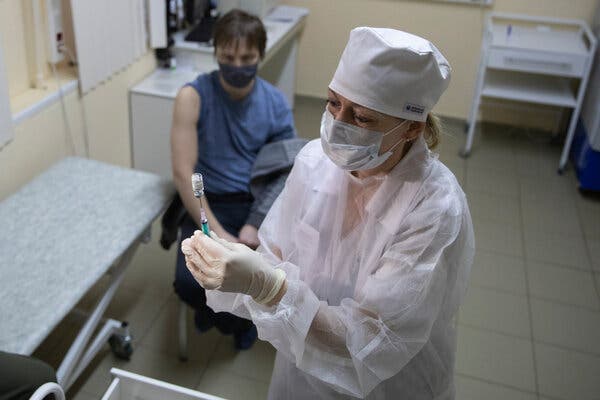
Russian vaccine scientists on Monday began a study to determine whether they can hasten the country’s campaign of coronavirus inoculations by providing only a single dose of its normally two-dose vaccine.
The idea, also under consideration in Britain and other countries, is that a single dose could provide more than half of the protection offered by a two-dose vaccine. While each vaccinated person would be less protected than if they had undergone the full inoculation cycle, the approach could potentially save more lives in the population as a whole.
Russia’s vaccine, called Sputnik V, uses two types of genetically modified human adenoviruses, which are common cold viruses. The new approach would administer only a single type of the cold virus in one shot, the group that developed the vaccine, the Gamaleya Research Institute, said on Monday.
The institute, part of the Russian Ministry of Health, will study the single-dose approach, called Sputnik Light, in 150 volunteers in Moscow and St. Petersburg. It was not clear when it hoped for results or when Russia might decide whether to switch tack to a single-dose strategy.
The institute’s director, Aleksandr Gintsburg, said in December that the single shot was likely to prove about 85 percent effective but would vary for different categories of patients. The two-shot regime showed an efficacy rate of 91.4 in clinical trials. President Vladimir V. Putin suggested the new tactic in December.
In the United States, President-elect Joseph R. Biden Jr. plans to end the practice of reserving the second shots of two-dose Pfizer and Moderna vaccines for those who have received a first shot. His administration would instead distribute nearly all available vials immediately.
But Biden officials do not intend to forgo the second shot; vaccine production, they have said, is expected to ramp up to meet demand for second shots. The Food and Drug Administration has recommended against tweaking the dosage schedules, which have been carefully studied in clinical trials.
world ROUNDUP
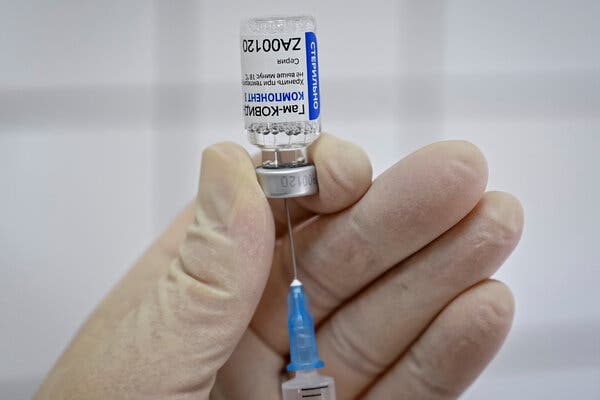
The Palestinian Authority has given emergency authorization to Russia’s Sputnik V Covid-19 vaccine, Health Minister Mai al-Kaila announced on Monday.
The Russian Direct Investment Fund, which financed Sputnik V, said that a first batch of doses was expected to be delivered to the Palestinians in February. The organization did not say how many doses would be sent.
Palestinians in the occupied West Bank and Gaza Strip have not received any significant shipment of vaccines yet. In her statement, Ms. al-Kaila said that health workers would be inoculated first when the vaccine arrives.
It was not clear whether a major Sputnik V shipment would be the first to reach the territories. Ali Abed Rabbo, a senior Health Ministry official, said last week that the Palestinians hoped to receive two million doses of the Oxford-AstraZeneca vaccine in February. Health officials now say they expect those doses to arrive in March.
The Palestinian Authority asked Israel in late December to provide it with up to 10,000 doses of vaccine to inoculate frontline medical workers, but the Israelis turned down the request, according to Hussein al-Sheikh, the top Palestinian official in charge of coordinating with Israel.
Israeli officials have said that vaccinating Palestinians was not their obligation or responsibility. The Palestinian Authority’s foreign ministry and human rights groups argue that international law obligates Israel to give doses to Palestinians living under occupation. Israeli officials have signaled that they may send doses to the Palestinian Authority once their own vaccination campaign is complete.
Israel has administered enough vaccines for 20 percent of its population so far, the highest proportion of any country, according to the research site Our World in Data, which is based at the University of Oxford.
In other developments around the world:
-
The health care system in Britain is facing “the worst weeks of this pandemic,” the government’s chief medical officer, Prof. Chris Witty, said on Monday, adding that hospitalizations in England had already far surpassed the spring’s peak. “This is an appalling situation,” Professor Witty told the BBC, warning that the impact of the vaccines would not be felt for several weeks. Seven new vaccination centers are set to open across England this week, with the government hoping to offer a vaccine to every adult by the fall.
-
Primary schools and kindergartens in Greece reopened on Monday after a two-month closure, as the authorities moved to partially lift a lockdown that has been in place since Nov. 7. The country’s secondary schools and universities remained closed, with lessons being conducted remotely.
-
Lebanese authorities tightened a nationwide lockdown Monday, including an 11-day, 24-hour curfew, The Associated Press reported. The move comes amid a dramatic surge in coronavirus infections and growing criticism of uncoordinated policies many blame for the spread of the virus. News of the restrictions to be implemented starting Thursday morning sparked panicked grocery buying as people lined up outside of supermarkets to stock up, raising fears the crowds could further spread the virus.
-
The city of Brisbane, Australia, will lift a strict three-day lockdown enforced last week after a case of the new variant of the coronavirus was recorded. The lockdown will end Monday evening, though masks will remain mandatory in crowded spaces in the city for another 10 days.
-
An annual ice and snow festival in China is going ahead as planned in the northeastern city of Harbin. The festival, which shut down early last year, opened last month. Visitors are required to show a “health code” on a contact-tracing app and have their temperatures checked before entering.
-
Indonesia authorized on Monday the emergency use of a Covid-19 vaccine made by Sinovac, a private Chinese company, after late-stage clinical data reaffirmed that the shot is effective. Inoculations are set to begin in the coming weeks with health workers, soldiers and police officers.
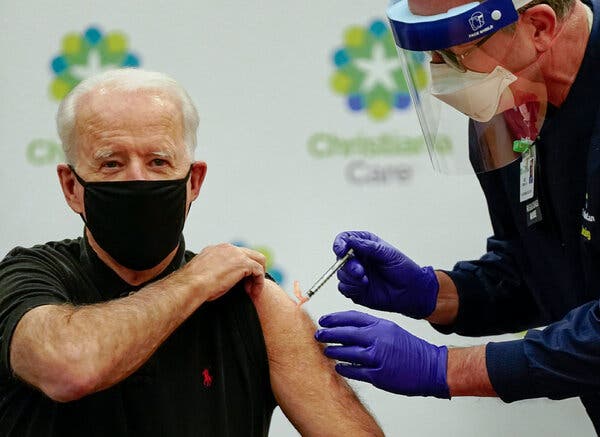
President-elect Joseph R. Biden Jr. received his second dose of the Pfizer-BioNTech coronavirus vaccine on Monday, completing his inoculation against Covid-19.
Mr. Biden took his first dose of the vaccine on Dec. 21. At least 151,000 people in the United States have been fully vaccinated, as of Jan. 8, according to a New York Times survey of all 50 states.
“My No. 1 priority is getting vaccine into people’s arms,” Mr. Biden said after taking a quick needle jab. The president-elect said he and his advisers are finalizing a plan to accelerate mass vaccinations nationwide that he will release on Thursday.
“Three to four thousand people dying a day is just beyond the pale,” he said.
Mr. Biden lamented that mask-wearing continues to be a politically divisive issue, and said he was “appalled” to hear that, during last week’s storming of the U.S. Capitol, some Republican House members refused pleas from a Democratic colleague to don masks while they were crowded together in a secure protective location.
The United States reported 300,594 new cases on Friday and more than 4,100 deaths on Thursday, both single-day records, according to a Times database. In total, more than 374,000 have died from issues related to the virus in the United States.
The emergence of more contagious variants has added urgency to the country’s vaccine rollout, which has gotten off to a slow start.





